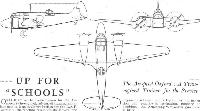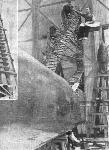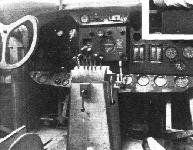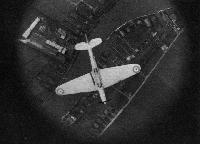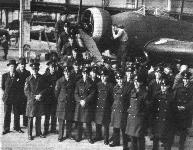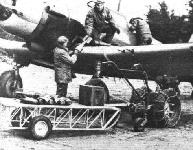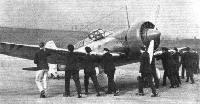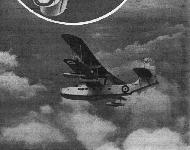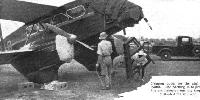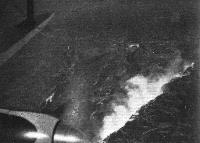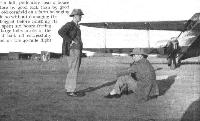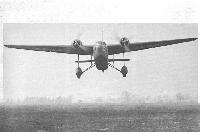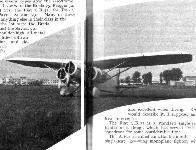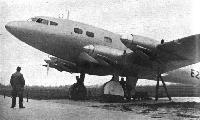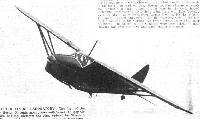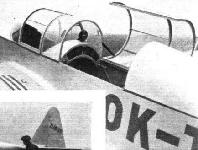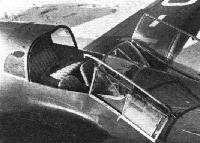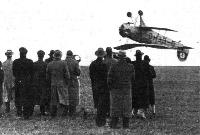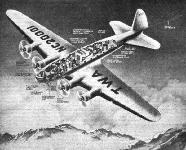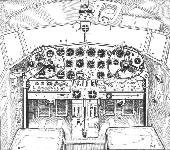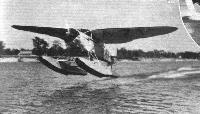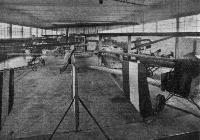Фотографии
-
A DAZZLER: A production-type Bristol Blenheim medium bomber (two Mercury VIIIs) "dazzle-painted" for entry into the Service. If the "paint-job" is as dazzling as the performance the machine should be practically invisible.
Самолёты на фотографии: Bristol Blenheim - Великобритания - 1936
-
Регистрационный номер: K5083 NEW GENERATION: This exclusive Flight photograph of the production-type Hawker Hurricane single-seater fighter and the "P.4" two-seater bomber in company near Brooklands anticipates the spectacles of formations of such impressive aeroplanes when, in the not-far-distant future, they are in service with the R.A.F. The Hurricane, which, like its flight companion, mounts the Rolls-Royce Merlin, has already been ordered in quantity. Flt. Lt. Bulman's homely headgear in this picture is a tribute to the civilising influence of the modern enclosed cockpit.
Самолёты на фотографии: Hawker Henley - Великобритания - 1937Hawker Hurricane - Великобритания - 1935
-
A Boeing P-26A fighter with combined wheel and ski undercarriage;
Самолёты на фотографии: Boeing P-26 Peashooter - США - 1932
-
Самолёты на фотографии: Airspeed Oxford / AS.10 - Великобритания - 1937
-
Literally "man's size," the Lockheed hydraulic undercarriage jacks, of which there are four, measure 54 in. in their closed position and 84 in. extended.
Самолёты на фотографии: Armstrong Whitworth Ensign / A.W.27 - Великобритания - 1938
-
One of the wings of tie Ensign, in which corrugated metal sheeting forms the upper and lower sides of the single box spar. The covering is partly of metal and partly of fabric. Only the leading-edge formers are in place in this view.
Самолёты на фотографии: Armstrong Whitworth Ensign / A.W.27 - Великобритания - 1938
-
FINDING ITS LEGS: The main spar and undercarriage are now in place on the first of the Armstrong Whitworth Ensigns for Imperial Airways. The undercarriage is the largest retractable type in the world and is of Armstrong Whitworth design and production, except for the Lockheed hydraulic rams.
Самолёты на фотографии: Armstrong Whitworth Ensign / A.W.27 - Великобритания - 1938
-
The after end: the fin skeleton.
Самолёты на фотографии: Armstrong Whitworth Ensign / A.W.27 - Великобритания - 1938
-
The Ensilage: Another view, taken in the shops, which gives an excellent idea of the massive proportions of the stressed skin body.
Самолёты на фотографии: Armstrong Whitworth Ensign / A.W.27 - Великобритания - 1938
-
The passenger seats in each cabin are of Imperial Airways' own design, and are instantly adjustable to any angle required by the user. This view is in the "mock-up" for the Empire-type Ensign.
Самолёты на фотографии: Armstrong Whitworth Ensign / A.W.27 - Великобритания - 1938
-
Some idea of the instrument and control layout can be gathered from this photograph of the "mock-up." On the throttle column can be seen the brake, flap, undercarriage, automatic pilot and v.p. airscrew controls, the positions of which are described in the accompanying article. In the centre is the Sperry panel, while on the left can be seen the essential navigational instruments.
Самолёты на фотографии: Armstrong Whitworth Ensign / A.W.27 - Великобритания - 1938
-
An Imperial Airways model of the Ensign
Самолёты на фотографии: Armstrong Whitworth Ensign / A.W.27 - Великобритания - 1938
-
It is no exaggeration to say that the A.W.27 »s the most advanced heavy transport landplane (in tlw stage and nature of its construction the degree of comfort and safety it affords its passengers) yet ordered by an airline. Powered with four Armstrong Siddeley Tiger IX fourteen-cylinder moderately supercharged and geared radial engines, its estimated maximum speed exceeds 200 m.p.h., the normal cruising speed being about 160 m.p.h. The total loaded weight is over 20 tons.
Самолёты на фотографии: Armstrong Whitworth Ensign / A.W.27 - Великобритания - 1938
-
One of the main stations on the trans-Canada route, the International Airport at Montreal.
Самолёты на фотографии: Fairchild FC-1 / FC-2 - США - 1926
-
Регистрационный номер: K5115 HASTY HAWKER: The data obtained on initial test flights by the Hawker pilots are secret, but observers at Brooklands are not finding it necessary to line up the new Hawker "P.4" light bomber between two points in order to detect movement. This Flight photograph shows how the Hawker technicians have strived to suppress parasitic excrescences.
Самолёты на фотографии: Hawker Henley - Великобритания - 1937
-
PEEPING ON A "P.4": The camera hole of a Swordfish and the accommodating piloting of Flt. Lt. Christopher Staniland offered Flights photographer this irresistible "shot" of the Fairey P.4/32 high-speed light bomber now undergoing contractor's trials at Heath Row.
Самолёты на фотографии: Hawker Henley - Великобритания - 1937
-
THE CRITICS: The Hawker staff at Brooklands have groomed enough thoroughbreds during the past few years to know a good aeroplane when they see one From "George" Bulman downwards the general opinion seems to be that the "P.4" light bomber will deliver the goods in true Hawker abundance.
Самолёты на фотографии: Hawker Henley - Великобритания - 1937
-
NOT SO ODIOUS: The Fokker photographer "shot" the new Faucheur attack machine - one of the sensations at the Paris Show last year. The Fokker, powered with two 750 h.p. small-diameter Hispanos, is estimated to do 280 m.p.h. at 11,500 ft. and has been flown for 14 hours. With Bristol Mercurys as fitted in the Blenheim it should do 292 m.p.h. at 14,500 ft.
Самолёты на фотографии: Fokker G.I Le Faucheur - Нидерланды - 1937
-
GEOGRAPHY AND GEODETICS: Vickers aircraft (on the marine side, at all events) are well known to men of the Royal Australian Air Force, so it was with keen interest that this Coronation contingent inspected the Weybridge works last week. They are seen in front of a Wellesley.
Самолёты на фотографии: Vickers Wellesley - Великобритания - 1935
-
The Vickers Wellesley, intended for general purpose work and long-range bombing operations. The engine is a Pegasus.
Самолёты на фотографии: Vickers Wellesley - Великобритания - 1935
-
The Breda 88 fighter-bomber in which the Italian pilot Furio Niclot gained for his country the speed records over 100 km. and 1.000 km., his average speeds being 321 and 295-odd m.p.h.
Самолёты на фотографии: Breda Ba.88 Lince - Италия - 1936
-
Caproni type seen at Montecelio. The new 135 bomber, seen by Capt. Macmillun in series production at the Caproni works. It can carry a ton of bombs 2,000 miles at 267 m.p.h.
Самолёты на фотографии: Caproni Ca.135 - Италия - 1935
-
Il Duce Mussolini, who is a qualified pilot, in the cockpit of a Caproni 135 during a visit to the Caproni works.
Самолёты на фотографии: Caproni Ca.135 - Италия - 1935
-
A Martin bomber is becoming "het-up."
Самолёты на фотографии: Martin B-10 / Type 139 / 166 - США - 1932
-
A Northrop attack monoplane being armed from a special tractor-drawn sledge (note two of the four wing-mounted Brownings);
Самолёты на фотографии: Northrop A-17 / 8A Nomad - США - 1934
-
Регистрационный номер: J-BAAI Divine Wind.
Самолёты на фотографии: Mitsubishi Ki.15/C5M/Karigane - Япония - 1936
-
Pilot's and navigator's cockpits. Note, in the latter, the fuel tanks, drift window, windows in the fuselage sides, radio and flying instruments.
The pilot’s (left) and navigator’s cockpits in the Kamikaze. Notable are the sideways-opening canopy in two sections, the fuel tanks, and the fuselage-side windows plus drift window in the floor of the rear cockpit.Самолёты на фотографии: Mitsubishi Ki.15/C5M/Karigane - Япония - 1936
-
Регистрационный номер: K5621 "WHERE THE LEAN FIN DOGS THE BOAT" (Kipling). The boat which this Shark dogs may be under the water or on the water; for torpedo work, spotting for guns, and general reconnaissance are all within the Blackburn's powers. It is seen on the waters of Gibraltar Harbour.
Самолёты на фотографии: Blackburn Shark / B-6 - Великобритания - 1933
-
Регистрационный номер: K7287 Самолёты на фотографии: Supermarine Stranraer - Великобритания - 1934
-
SEA LAWYER AND WARRIOR: A contrast in shapes and sizes is offered by this pose of a Vought V-143 single-seater fighter in the shade of a Sikorsky S-43 amphibian. The V-143 does 280 m.p.h. with a P. and W. Twin Wasp Junior and the amphibian 190 m.p.h. with two Hornets.
Самолёты на фотографии: Sikorsky S-43 Baby Clipper/JRS/Y1OA-8 - США - 1936Vought V-141 / V-143 / V-150 / Northrop 3A - США - 1935
-
Регистрационный номер: LN-DAG AMPHIBIOUS COLLABORATION: When D.N.L. eventually work on the Newcastle-Stavanger service it is probable that a Sikorsky S.43 will be used. This photograph shows the company's first machine of this type at Stavanger. In the foreground, with D.N.L.'s agent, is Mr. Bernt Balchen, the famous pilot.
Самолёты на фотографии: Sikorsky S-43 Baby Clipper/JRS/Y1OA-8 - США - 1936
-
After the landing in a field at King William's Town. The machine took off from the road in the foreground.
Самолёты на фотографии: De Havilland Dragon Rapide / Dominie / D.H.89 - Великобритания - 1934
-
Pegging down for the night at Kano. The sacking is to protect the windscreen from the tropical sun - but the sun won.
Самолёты на фотографии: De Havilland Dragon Rapide / Dominie / D.H.89 - Великобритания - 1934
-
Victoria Falls seen over one of the Gipsy Sixes of the Rapide.
Самолёты на фотографии: De Havilland Dragon Rapide / Dominie / D.H.89 - Великобритания - 1934
-
The passenger (Mr. F M. S. Tegner) and mechanic (Mr. G. J. Frisby) during a two-hour wait at Khartoum for "Customs."
Самолёты на фотографии: De Havilland Dragon Rapide / Dominie / D.H.89 - Великобритания - 1934
-
Регистрационный номер: K6947 Harrow K6947 photographed at Radlett during a test flight before delivery to 37 Squadron early in 1937.
HEAVYWEIGHT HEAD-ON: A Handley Page Harrow heavy bomber on test prior to delivery to an R.A.F. unit. The Harrow is being produced for the Air Ministry in two forms: the Harrow Mk. I has moderately supercharged Pegasus Xs (850 h.p. at 4,000 ft.) and the Mk. II mounts Pegasus XXs, which are fully supercharged and give 820 h.p. at 9,000 ft. Nose, midships and tail gun positions are incorporated and Handley Page slots and slotted flaps confer a wide speed range. Alternatively to its bombing activities the Harrow may be used as a troop transport.Самолёты на фотографии: Handley Page Harrow / H.P.54 - Великобритания - 1936
-
A SHADY CUSTOMER: "Shadow shading" is the Air Ministry's term for the new system of camouflage, here seen applied to a Handley Page Harrow.
Самолёты на фотографии: Handley Page Harrow / H.P.54 - Великобритания - 1936
-
Caproni type seen at Montecelio. The 133 (three 430 h.p. Piaggio radials), a type widely used in the Abyssinian campaign.
Самолёты на фотографии: Caproni Ca.133/148 - Италия - 1934
-
SAILOR BEWARE! A precursor of machines to span the Atlantic with heavy cargoes, the De Havilland Albatross, examples of which have been ordered by the Air Ministry for experimental flights between the Old and New Worlds, is one of the most striking British aircraft to be seen for many a year.
Самолёты на фотографии: De Havilland Albatross / D.H.91 - Великобритания - 1937
-
The D.H. Albatross posed for photographs to show such features as the installation of the four Gipsy Twelves with their amazingly compact cowlings and leading-edge intakes for the cooling air, the retractable undercarriage and the general aerodynamic excellence of the whole machine.
Самолёты на фотографии: De Havilland Albatross / D.H.91 - Великобритания - 1937
-
Самолёты на фотографии: De Havilland Albatross / D.H.91 - Великобритания - 1937
-
ANOTHER FLYING LABORATORY: The first of the new Heston Phoenix monoplanes with Series II Gipsy Six engine and v.p. airscrew has been ordered by Standard Radio and will be used for experimental and demonstration work.
Самолёты на фотографии: Heston Phoenix - Великобритания - 1935
-
Mm. Pissavy and Cornet with their Vega Gull at Le Bourget last Sunday on their arrival from French Indo-China in record time.
Самолёты на фотографии: Percival Vega Gull / K.1 - Великобритания - 1935
-
Регистрационный номер: OK-TBK [2] The Zlin XII. It will be noticed that the hinged covers for each cockpit carry large sliding panels, which when open should make the machine comfortably cool in hot weather.
Самолёты на фотографии: Zlin Z-XII - Чехословакия - 1935
-
Регистрационный номер: OK-TBK [2] Самолёты на фотографии: Zlin Z-XII - Чехословакия - 1935
-
Регистрационный номер: D-IAJO Самолёты на фотографии: Messerschmitt Bf.108 Taifun - Германия - 1934
-
The cabin doors of the Typhoon can be removed bodily to form emergency exits.
Самолёты на фотографии: Messerschmitt Bf.108 Taifun - Германия - 1934
-
Регистрационный номер: D-EEHO LOW-DOWN TRICK: Count Hagenburg, who won the International Competition for inverted flying at Zurich in 1936, goes into training for this year's event, for which he is a hot favourite. His mount is a Bucker Jungmeister with 160 h.p. Siemens engine. The photograph is not a faked one.
Самолёты на фотографии: Bucker Bu.133 Jungmeister - Германия - 1935
-
Caproni type seen at Montecelio. The 111, usually fitted with an 830/970 h.p. eighteen-cylinder Isotta-Fraschini water-cooled engine.
Самолёты на фотографии: Caproni Ca.111 Pancho - Италия - 1932
-
Регистрационный номер: NC20001 The Ensign's U.S. counterpart: A drawing indicating certain of the salient features of the Boeing 307.
Самолёты на фотографии: Boeing Boeing 307 Stratoliner - США - 1938
-
Регистрационный номер: G-AEPN Lockheed Model 10
Самолёты на фотографии: Lockheed Electra 10 - США - 1934
-
Inside the control cabin of one of British Airways Electras. The central throttle bank carries c.s. airscrew controls on the left and mixture controls on the right, while below are the undercarriage, flap, and carburettor-heater controls. Among the less usual instruments may be seen the mixture analyser (behind the throttles), the cylinder-head and outside air temperature gauges, and the blind approach indicator. The wireless panel and controls on the right have now been removed, since the operator has his own premises aft of the pilot's cabin. Behind the port wheel can be seen the Lorenz blind-approach dial, a radio homing indicator and the normal Sperry equipment. Behind the port throttle lever is the exhaust gas analysing indicator - especially necessary with constant-speed airscrews.
Самолёты на фотографии: Lockheed Electra 10 - США - 1934
-
This drawing of the control cabin of the Lockheed Electra shows all (or nearly all!) the controls and instruments. In the interests of clarity the former have been distinguished from the latter by the use of letters instead of numbers.
(A) Throttles (B) Airscrew governor controls. (C) Mixture controls. (D) Undercarriage control. (E) Flap control. (F) Brake lever. (G) Carburettor heater controls. (H) (beside seat) Emergency undercarriage control, fuel dump valves and master switch. (J) Fuel valves. (K) Ignition controls. (L) Directional trimmer. (M) Fore and aft trimmer (N) Emergency fuel pump. (O) Engines primer. (P) Vacuum switch-over. (Q) Marconi remote panel and controls. (R) Marconi remote control for D/F loop. (S) Lorenz control panel. (T) Cabin temperature control. (U) General switchboard and de-icer regulator.
(1) Air-speed indicator (2) Sperry horizon and gyro. (3) Turn indicator. (4) Rate-of-climb indicator. (5) Kollsman sensitive altimeter. (6) Compasses. (7) Marconi homing indicator. (8) Lorenz indicator. (9) Manifold pressure gauges. (10) Revolution counters, (11) Cambridge exhaust analyser. (12) Flap indicator. (13) Carburettor temperature gauges. (14) Cylinder head temperature gauge. (15) Fuel gauge dials and switches. (16) Undercarriage warning lights. (17) Vacuum indicator. (18) Air temperature gauge. (19) Passengers' signal light.Самолёты на фотографии: Lockheed Electra 10 - США - 1934
-
Регистрационный номер: CF-AZI The American private-owner type equipped with Edo floats: the latest Stinson Reliant
Самолёты на фотографии: Stinson Reliant - США - 1933
-
The American private-owner type equipped with Edo floats: a Waco - with the amphibious type.
Самолёты на фотографии: WACO C / S Series - США - 1931
-
Регистрационный номер: I-CANT UNDULY PESSIMISTIC: Despite the apparent faintheartedness of its registration this new Italian Cant. 506 commercial seaplane has beaten eight international records for speed with load. Twelve passengers are normally accommodated and the maximum speed is something like 200 m.p.h.
Самолёты на фотографии: CANT Z.506 Airone - Италия - 1935
-
Регистрационный номер: J-AAMB FLEET FIGHTER - MAIL CARRIER: Built some years ago by Glosters as a fleet tighter for the Japanese Navy this Gambet, or Navy Type 3, single-seater has been modified for service as a mail carrier. The engine is a 450 h.p. Jupiter VI.
Самолёты на фотографии: Gloster Gambet - Великобритания - 1927
-
The famous Italian record-breaker. The Macchi-Castoldi 72 (3,000 h.p. 24-cylinder Fiat), which still holds the world's air speed record of 440.677 m.p.h., made in 1934.
Самолёты на фотографии: Macchi MC.72 - Италия - 1931
-
The flying boat is the Cant. Z.508 which carried ten tons to 4,863 metres.
Самолёты на фотографии: CANT Z.508 - Италия - 1936
-
In the Caproni works museum. In the background is one of the big triplane bombers of the Great War, and a smaller triplane is seen on the right.
Самолёты на фотографии: Caproni Ca.4 - Италия - 1916Caproni Ca.53 - Италия - 1917
-
COUPE DEUTSCH CUM COMET: With a view to attacking a number of long-distance records, including that for 5,000 km., the French pilot Rossi has been testing his Renault-engined Caudron Typhon at Istres aerodrome.
Самолёты на фотографии: Caudron C.640 Typhoon - Франция - 1935
-
Регистрационный номер: СССР-Н205 PROLETARIAN INTEREST: Californians cast a critical eye over a Douglas DF flying boat (two 850 h.p. Cyclone Gs) for Soviet Russia. The outboard floats are retractable. A maximum speed of 178 m.p.h. is claimed and the disposable load is 11,185 lb.
Самолёты на фотографии: Douglas DF - США - 1936
-
FASTEST IN SERVICE: The Fiat APR.2 (two 700 h.p. Fiat-built Hornets), a twelve-passenger machine, used on Ala Littoria's Milan-Turin-Paris service. It cruises at about 217 m.p.h., over 240 m.p.h. being attained at full throttle, and is believed to be the world's fastest transport in regular use. Le Bourget's new building forms the background.
Самолёты на фотографии: FIAT APR.2 - Италия - 1935
-
Регистрационный номер: NR1313 TIME FLIES: Even the hustlers and bustlers of New York paused recently to goggle at Capt. Frank Hawks' new monoplane, with which, sponsored by an American watch company, he hopes to make his "come-back" in the record-breaking game. The engine is a Pratt and Whitney Twin Wasp of over 1,000 h.p. The undercarriage is retractable - and so are both pilot and windscreen: after reaching his altitude Hawks lowers his seat, and the screen automatically closes flush with the fuselage.
Самолёты на фотографии: Travel Air Type R Mystery Ship - США - 1929
-
This sketch of the interior of the "survey" Double Eagle not only shows the majority of the control and other details but also gives a good indication of the field of view provided for the pilot, whose seat is shown in skeleton form. The first nine of the key numbers below apply to the automatic pilot equipment.
(1) Main control and catch lever. (2) Coarse and fine directional adjustment controls. (3) Fore and aft control. (4) Lateral control. (5) Air-driven compressor brake lever. (6) Aileron pilot unit. (7) Oil reservoir. (8) Air drier. (9) Test cock. (10) Airscrew pitch controls (11) Undercarriage and flap controls, (12) Fore and aft trimmer. (13) Directional trimmer. (14) Drift sight control. (15) Heater controls. (16) Seat-raising lever. (17) Undercarriage and flap pump lever. (18) Brake lever. (19) Camera. (20) Heater grilles.Самолёты на фотографии: British Aircraft BA.IV Double Eagle - Великобритания - 1936
-
A view through the rear bulkhead, looking towards the tail of the machine and showing the position of the rudder and elevator automatic pilot units and the battery, which is normally boxed in so that no fumes shall upset the operation of the automatic pilot units.
Самолёты на фотографии: British Aircraft BA.IV Double Eagle - Великобритания - 1936
Статьи
- Flight
- Flight Advertisements



